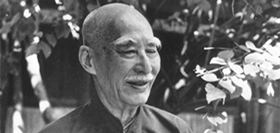Confucianism, Taoism, Buddhism impact traditional Chinese culture
Author : Hong Xiuping Source : Chinese Social Sciences Today 2015-01-20
Confucianism, Taoism and Buddhism all form the essence of traditional Chinese culture. Historically, all three beliefs have complemented and conflicted with each other at different times. Contention of different schools of thought was encouraged in China even before the Qin Dynasty (221-206 BC). After the Han Dynasty (206 BC-AD 220), Confucianism and Taoism came to the fore out of hundreds of schools of thought. Both coexisted with Buddhism, which was introduced to China by India in the Han Dynasty. Buddhism became involved in complicated relationships with Confucianism and Taoism, conflicting and blending with the two major Chinese philosophies.
However, all three teachings have the sociocultural function of humanizing the general populace. After more than 2,000 years of development, Confucianism, Taoism and Buddhism have become quintessential components of traditional Chinese ideological culture.
Diversity in thinking
Integrating amid conflict and developing amid integration, the three systems of thought jointly shaped the profile of the traditional Chinese ideology and pointed to the direction of its development. The interrelationship among Confucianism, Taoism and Buddhism is therefore an important point of departure for understanding traditional Chinese culture.
In essence, traditional Chinese thinking is human-centered and aimed at pursuing social stability, harmony and happiness. Although gods and deities are above all other things, there are regarded as important forces to ensure happiness in life.
Despite divided doctrines, many schools of thought in China attach importance to people and their lives. In philosophy, this involves recognizing the subject value of people. Varying from each other in certain views, diversified beliefs have contributed to the rich and profound philosophy of China.
Interaction among three beliefs
Buddhism emphasizes “no-self,” regarding life as an abyss of misery. It is therefore committed to breaking the cycle of birth and death. After Buddhism arrived in China, it was widely spread with the ultimate doctrine that “everyone has a Buddhist nature.” Chinese Buddhism is therefore characterized by subjectivity and individuality.
This characteristic results from Buddhism’s interaction with Confucianism and Taoism. From the interrelationship among the three philosophies, the human nature of traditional Chinese culture clarified and the integrated development of Buddhism with Confucianism and Taoism manifested.
In terms of fundamental features of the three ideological systems, Confucianism focuses on moral obligations and preaching; Taoism focuses on the pursuit of longevity and immortality; and Buddhism encourages people to stand aloof from worldly affairs.
Confucianism, which originally upheld “abstinence,” adopted the Buddhist idea that “only after getting rid of desires can scholars dedicate themselves to academic studies.” Taoism, which stressed seeking longevity and immortality, also drew upon Buddhist ideas, maintaining that only through many lives of self-cultivation can people break away from reincarnations and become immortals. Buddhism, aimed at annihilation of the birth-death cycle referred to Taoist notions, pledged to learn from immortals and pursue longevity to protect the religion’s founder Saddhamma.
Confucianism dominance
With the localization of Buddhism in China and “Confucianization” of Taoism, the three teachings gradually evolved to share Confucian doctrines. In the Eastern Jin Dynasty (317-420), Taoism held that “those aiming for longevity should act upon loyalty, filial piety, gentility, humanity and integrity; if they don’t strive for these virtues, they will not achieve immortality even if they have mastered alchemical formulas.”
Originally, Buddhism held that all beings in the six realms of existence (gods, demi-gods, humans, animals, hungry ghosts and hells) are parent and child to each other. Difficulty in clarifying the exact kinship means there is no need to cling to worldly parent-child relations and practice filial piety, according to Buddhist doctrine.
However, Chinese Buddhism advocates filial piety as Confucianism does and even regards it as an unquestionable moral truth. The emphasis and highlight of filial piety becomes one of the characteristics of Chinese Buddhism.
It can be seen that as the three systems of thought interacted, their doctrines also changed and influenced traditional Chinese culture.
Revelation to reality
For more than 2,000 years, Confucianism, Taoism and Buddhism developed amid conflict, integration and complementation. Sometimes conflict promoted integration, while other times integration intensified conflict.
For example, the alliance of Confucianism and Taoism against Buddhism resulted in Buddhism blending with Confucianism and Taoism. Meanwhile, Buddhists’ criticism of Taoism for seeking immortality also drove Taoists to absorb Confucian and Buddhist theories to evolve its own theoretical system and eventually make a clean break from traditional Taoism.
Historically, traditional Chinese culture excluded non-homegrown Buddhism to retain its unique charm and ensure its stable development. However, it also selectively embraced valuable elements of Buddhism to enrich and renew itself continuously.
Dual attitudes of traditional Chinese culture towards the first massive introduction of external culture and resultant successful infusions continue to inspire today’s cultural advancement in China.
Buddhism came to China in the Han Dynasty, which is when the formal Confucianism-Taoism-Buddhism relationship started. Nevertheless, understanding the relationship between Confucianism and Taoism before the import of Buddhism is the precondition for understanding Buddhism’s relations with the other two philosophical systems and an important elemment of the triadic relationship.
Confucianism, Taoism and Buddhism are all broad, profound systems of thought in traditional Chinese culture, permeating the daily lives of Chinese people and represented in a variety of literary and art forms. The triadic relationship is therefore not only an object of academic research, but also a reflection of complicated social phenomena, and even an embodiment of life practice and wisdom.
The author is a professor at the Department of Philosophy at Nanjing University.
The Chinese version appeared in Chinese Social Sciences Today, No. 684, December 24, 2014.
The Chinese link: http://sscp.cssn.cn/xkpd/zjx_20158/201412/t20141224_1454453.html
Translated by Chen Mirong
Revised by Tom Fearon
Ye Shengtao made Chinese fairy tales from a wilderness
Ye Shengtao (1894–1988) created the first collection of fairy tales in the history of Chinese children’s literature...
-
How northern ethnicities integrated into Chinese nation
2023-09-18
-
Mogao caves
2023-09-12
-
Mogao Grottoes as ‘a place of pilgrimage’
2023-09-12
-
Time-honored architectural traditions in China
2023-08-29
-
Disentangling the civilizational evolution of China
2023-08-28
-
AI ethics in science fiction
2023-08-23














 2011-2013 by www.cssn.cn. All Rights Reserved
2011-2013 by www.cssn.cn. All Rights Reserved